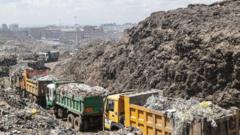What Are the 5 Key Facts to Know as Afghanistan Enters Its Fifth Year Under Taliban Rule?

Understanding the Taliban's Governance Challenges in Afghanistan
The Taliban's return to power in Afghanistan in 2021 marked a significant shift in the political landscape of the country. As the group approaches its fifth year in control, it faces a multitude of challenges that will test its ability to lead effectively. The interplay of climate change, an increasing population, and severe cuts to foreign aid significantly complicates the Taliban's governance. While the Taliban has a stronghold on power, ruling through decrees, the aspirations and needs of the Afghan population cannot be satisfied by ideology alone. This article explores five critical aspects of the Taliban's governance and the challenges it faces.
The Supreme Leader's Vision
At the helm of the Taliban is Hibatullah Akhundzada, whose leadership has transformed the group from an insurgent faction into a governing authority since his ascension in 2016. Akhundzada's vision has been clear: to establish a rigid Islamic system that permeates every aspect of Afghan life. His ratification of the Propagation of Virtue and Prevention of Vice Law exemplifies this commitment, as it codifies societal behaviors and interactions, thus embedding his interpretation of Islamic law into daily life.
In a declaration made in June, Akhundzada emphasized the sacrifices made by the Taliban for the implementation of Islamic law, asserting that obedience to the leadership is not merely a duty but a divine obligation. This assertion stems from his self-declared superior religious authority, which his supporters uphold fervently. The education minister further escalated the rhetoric by equating any criticism of Akhundzada with blasphemy, reinforcing the idea that dissent is not just discouraged but deemed sinful.
Internal Dynamics and Power Struggles
Despite the seemingly unified front, internal differences within the Taliban have surfaced. Early on, there were factions advocating for a relaxation of restrictions on women and girls, seeking to enhance Afghanistan’s global engagement and financial prospects. However, Akhundzada’s influence has overshadowed these voices, allowing him to maintain a tight grip on power. His dominance has further marginalized key figures, such as Interior Minister Sirajuddin Haqqani, who previously held significant sway but now finds himself sidelined.
Akhundzada has effectively consolidated control over Afghanistan’s military resources, diminishing the roles of the Interior and Defense Ministries. This centralization of power has resulted in the suppression of dissent within the ranks, as seen when political deputy Sher Abbas Stanikzai openly challenged Akhundzada's education bans but subsequently left the country, highlighting the risks faced by dissenters.
The Plight of Afghan Women and Girls
The humanitarian implications of the Taliban’s governance extend deeply into the lives of Afghan women and girls. Following their return to power, the Taliban has systematically excluded women from public life, instituting policies that stifle their rights and freedoms. The recognition of the Taliban by Russia has been interpreted by many as a troubling endorsement of their oppressive practices, reinforcing the notion that the international community may tolerate human rights violations for political expediency.
Despite the pervasive fear that silences public dissent, the desire for change persists among women in Afghanistan. They are preparing themselves intellectually and emotionally for a future that may one day allow for their rights to be restored. The absence of visible protests does not equate to acceptance; rather, it reflects the climate of fear and repression that has taken hold since the Taliban's return to power.
Transactional Regional Relationships
The Taliban’s foreign relations are shaped not by trust or shared values but by transactional agreements. Afghanistan’s geographical positioning—bordering multiple countries—positions it as a strategic player for nations seeking access to energy resources and trade routes. The Taliban’s interactions with neighboring countries are grounded in mutual interests, focusing on security, trade, and resource management.
Recent trends indicate a shift towards normalization and appeasement of the Taliban, as regional powers engage with them despite their human rights record. The continued neglect of Afghan women's rights in favor of political interests is a painful reality for many observers, indicating that the humanitarian crisis is often overshadowed by geopolitical concerns.
The Impending Governance Crisis
The Taliban’s governance will face a critical test as cuts to foreign aid and the growing population of Afghanistan present insurmountable challenges. The U.S. previously served as the largest donor to Afghanistan, but the cessation of aid has left a significant gap in the country’s financial stability. With over half of the population reliant on aid for survival, the impending loss of jobs and resources will exacerbate existing tensions and may lead to widespread unrest.
The World Health Organization projects a drastic increase in Afghanistan’s population in the coming decades, which will further strain the already limited resources and services available. The Taliban must confront a pivotal question: do they wish to govern merely to exert control, or do they aim to foster an environment that improves the quality of life for their citizens?
Conclusion
The Taliban’s governance in Afghanistan is at a crossroads, where the implications of climate change, population growth, and international relations will shape its future. The challenge lies not only in ruling but in leading with a vision that addresses the diverse needs and aspirations of the Afghan people. As they navigate these complexities, the fundamental question remains: will the Taliban adapt to become a governing body that prioritizes the welfare of its citizens, or will it continue to rule through authoritarian decrees without regard for the realities on the ground?
Frequently Asked Questions
What are the main challenges facing the Taliban in Afghanistan?
The Taliban faces challenges from climate change, a growing population, and significant cuts to foreign aid, which complicate governance and the provision of basic services.
How has the Taliban's leadership impacted women's rights in Afghanistan?
The Taliban's leadership has resulted in the systematic exclusion of women from public life, with policies that restrict their rights and freedoms significantly.
What is the nature of the Taliban's relationships with neighboring countries?
The Taliban's foreign relations are largely transactional, focusing on mutual interests such as trade and security rather than shared values or trust.
How has international recognition of the Taliban affected its governance?
International recognition, particularly from countries like Russia, has emboldened the Taliban, allowing them to maintain oppressive policies without facing significant consequences.
As we consider the future of Afghanistan under Taliban rule, we must reflect on the critical balance between authority and governance. How will the Taliban navigate the pressing needs of its citizens while maintaining its ideological commitment? #Afghanistan #Taliban #HumanRights
Published: 2025-08-15 05:31:47 | Category: Trump GNEWS Search



